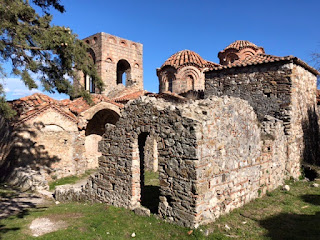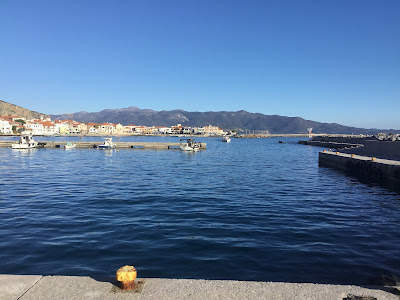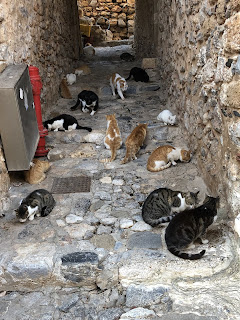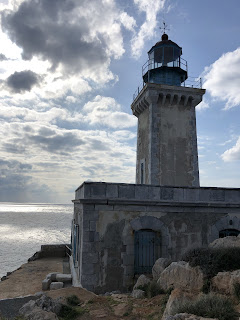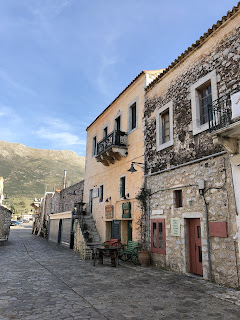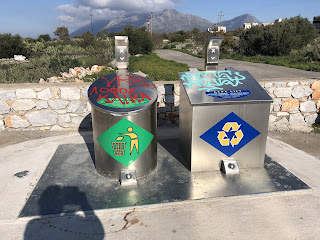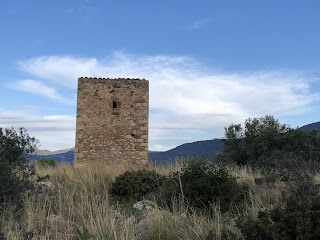The truck driver waved us back from where he had been surveying the road ahead, and we pulled over against the wall of the village church to wait. He jumped into his cab and reversed towards us, revealing a large bus ahead. Then we realised the bus was also reversing, also towards us. What on earth was ahead? We soon saw. It was a huge curtain-sided truck with a trailer almost as big. The bus swung into a small square, the truck ahead of us tried to get down a side street, but realised it wouldn’t make it, so the truck and trailer crept back a few feet to allow him to sneak through the gap. We pulled into a small alcove, and the behemoth went on its way.
It’s amazing we haven’t seen more such incidents in Greece, as the main roads often go through tiny villages with sharp turns, nasty overhangs, and room enough for only one vehicle. There are plenty of convex mirrors to help see around corners, but it can still be a little disconcerting. What’s made it so much easier is that there is so little traffic, and that Greek drivers are generally good natured and rarely in a hurry, especially in Laconia, from where we get the word laconic. In the next village along we stopped to wait while a conversation between two drivers was concluded through open windows as they passed in the road. And they never give the impression that we shouldn’t be in their road, they just pull through the narrowest of gaps and go on their way.
 |
| Leonidas, hero of Thermopylae |
We were heading east from Sparta, climbing into the mountains which separate it from the sea, as we start heading north towards the Isthmus of Corinth. It was our second visit to Sparta in 48 hours. We’d arrived there on Monday, having had a lazy weekend in the small harbour town of Plitra, and at a quiet beach stop we’d used a few days before on our way to Monemvasia. It was ideally situated to do our weekly shop at the Lidl in Skala on Monday morning. Who should be in the car park, but a German couple in a Motorhome we’d seen back in Thessalonika, and then at Thermopylae, and again at Monemvasia. They are clearly doing a similar route, but they speak no English and our conversations have been friendly, but limited.
We were delighted to discover that Sparta has wide boulevards with a central reservation, making it easy to drive through the town to a side road where we could park up for the night, just around the corner from the ruins of the old town. In the morning we dropped off our dirty clothes at a laundry, before learning that Ancient Sparta is closed on Tuesdays. A quick replan, and it was off to the old Byzantine capital of Greece at Mythras, just twenty minutes outside Sparta.
 |
| Sparta from Mythras |
 |
| The fortress at Mythras |
 |
| The palace as you approach |
 |
| And from the other side |
After lunch we explored the fortress and most of the upper town, deciding that was probably sufficient for one day. It was enough to see the fabulous construction of the innermost keep, high up in the top of the rock. From there we wandered down steep alleys, stepping into churches and ruined monasteries, and gazing at the immense restored palace built by sons of the Byzantine Emperor in Constantinople who had turned the Peloponnese into a despotate in the mid-fourteenth century. Below us were more beautiful monasteries, but we enjoyed the view and declined the trek down... and the inevitable return journey.
We spent a quiet night in the car park, taking the spaniels for a wander up the hill for more breathtaking views the next morning. Then it was back to Sparta to pick up the laundry and go for a brief wander around the old town. The laundry was beautifully cleaned and folded, two loads for €20, but to our amusement was several shades pinker than we had left it. How had we managed to wash Nick’s red t-shirt for six months without doing the same?
Sparta’s old town has been pillaged too often to be more than a vague outline, but there is an impressive Roman theatre, some remains of early Byzantine churches, and a few bits of ancient temple. Entry was free, so we weren’t expecting more, but it was an enjoyable wander. Finally it was time to leave the province of Laconia and return to Arcadia. We are spending the night in a quiet lay-by in the mountains, where to our great surprise, my altimeter tells me we are at 1199 metres - almost 4000 ft. More hairpins tomorrow then.
 |
| The theatre in Sparta |


